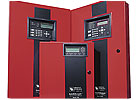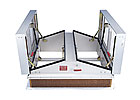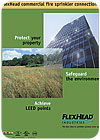
Experts agree that the biggest trend in the fire protection industry today is residential fire sprinklers. This is especially true for single homes, as well as apartments and condominiums. ASPE President Julius Ballanco, P.E., CPD, concurs: “There is a major push to mandate residential sprinklers in all dwelling units. The manufacturers are gearing up by providing newer low flow K=3.0 sprinklers. They also have bypass valves for residential systems, newer alarms, etc.”
He adds, “Sprinkler manufacturers are also trying to figure out how to distribute through the normal plumbing wholesale distribution outlets. They realize that with residential sprinklers, many traditional plumbing contractors will be installing the system.”
Apparently, keeping the sprinkler contractors happy while inviting plumbing contractors to obtain the training to install residential sprinklers is a major issue right now. “The manufacturers are in a precarious position trying to serve both industries,” Ballanco notes. He cites the example of a supplier of resin for a sprinkler pipe manufacturer who has taken the position that the particular brand he supplies should be installed only by sprinkler contractors, not plumbing contractors. However, the sprinkler pipe manufacturers take a different view. “They want to sell pipe,” Ballanco says.
According to fire protection specialist Mark Bromann, SET, CFPS, other major issues affecting the industry are:
Manufacturers are also affecting the industry in terms of flexibility and cost savings. “All manufacturers are looking at additional pipe fittings to install multipurpose piping systems (combined residential sprinkler and cold water plumbing),” Ballanco says. “The concept is to allow for greater flexibility.
“Manufacturers are also looking at ways to assist in sprinklering large storage buildings in a more economical way,” he adds. “There are newer sprinklers for these storage-type buildings.”
Another trend to be on the lookout for is PEX. Manufacturers of this material are expected to make a bigger splash into the residential sprinkler market.
Bromann predicts a sunny outlook for 2008: “The industry is involved mostly in new construction projects, more and more residential and still more retrofits every day.”

Featured Products Gallery
Bilcooffers its domed automatic fire vent that features a more attractive design and provides enhanced thermal insulation properties. The Lumivent provides natural daylight, energy efficiency and the protection of automatic fire venting. It is designed to open automatically in the event of fire, allowing smoke, heat and gases to escape.

In addition, HFSC launched a new animated educational Web site, www.SprinklerSmarts.org, offering interactive games for children, while also providing teaching materials to public educators, teachers and parents.


